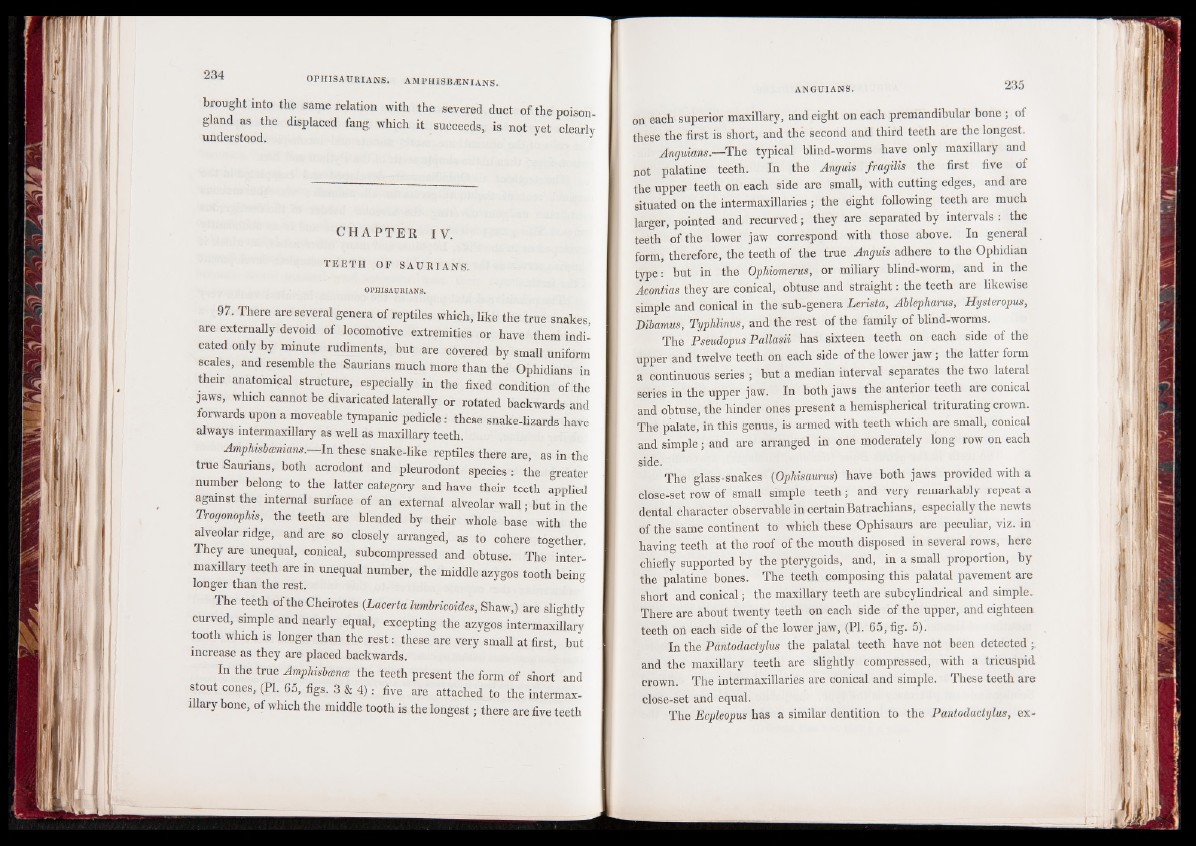
brought into the same relation with the severed duct of the poison-
gland as the displaced fang; which understood. it ' succeeds,, is not yet clearlyJ
C H A P T E R IV.
t e e t h o f s a u r i a n s .
OPHISAURIANS.
97. There are several genera of reptiles which, like the true snakes,
are externally devoid of locomotive extremities or have them indicated
only by minute rudiments, but are covered by small uniform
scales, and resemble the Saurians much more than the Ophidians in
their anatomical structure, especially in the fixed condition of the
jaws, which cannot be divaricated laterally or rotated backwards and
forwards upon a moveable tympanic pedicle: these snake-lizards have
always intermaxillary as well as maxillary teeth.
Amphisbxnians. In these snake-like reptiles there are, as in the
true Saurians, both acrodont and pleurodont species: the greater
number belong to the latter category and have their teeth applied
against the internal surface of an external alveolar wall; but in the
Trogonophis, the teeth are blended by their whole base with the
alveolar ridge, and are so closely arranged, as to cohere together.
They are unequal, conical, subcompressed and obtuse. The intermaxillary
teeth are in unequal number, the middle azygos tooth being
longer than the rest.
The teeth oftheCheirotes (Lacerta lumbricoides, Shaw,) are slightly
curved, simple and nearly equal, excepting the azygos intermaxillary
tooth which is longer than the rest: these are very small at first, but
increase as they are placed backwards.
In the true Amphisbames the teeth present the form of short and
stout cones, (PI. 65, figs. 3 & 4): five are attached to the intermaxillary
bone, of which the middle tooth is the longest | there are five teeth
on each superior maxillary, and eight on each premandibular bone ; of
these the first is short, and the second and third teeth are the longest.
Anguians.—The typical blind-worms have only maxillary and
not palatine teeth. In the Anguis fragilis the first five of
the upper teeth on each side are small, with cutting edges, and are
situated on the intermaxillaries ; the eight following teeth are much
larger, pointed and recurved; they are separated by intervals: the
teeth of the lower jaw correspond with those above. In general
form, therefore, the teeth of the true Anguis adhere to the Ophidian
type: but in the Ophiomerus, or miliary blind-worm, and in the
Acontias they are conical, obtuse and straight: the teeth are likewise
simple and conical in the sub-genera Lerista, Ablepharus, Hysteropus,
Dibamus, Typhlinus, and the rest of the family of blind-worms.
The Pseudopus Pallasii has sixteen teeth on each side of the
upper and twelve teeth on each side of the lower jaw; the latter form
a continuous series ; but a median interval separates the two lateral
series in the upper jaw. In both jaws the anterior teeth are conical
and obtuse, the hinder ones present a hemispherical triturating crown.
The palate, in this genus, is armed with teeth which are small, conical
and simple; and are arranged in one moderately long row on each
side. The glass-snakes (Ophisaurus) have both jaws provided with a
close-set row of small simple teeth; and very remarkably repeat a
dental character observable in certain Batrachians, especially the newts
of the same continent to which these Ophisaurs are peculiar, viz. in
having teeth at the roof of the mouth disposed in several rows, here
chiefly supported by the pterygoids, and, in a small proportion, by
the palatine bones. The teeth composing this palatal pavement are
short and conical; the maxillary teeth are subcylindrical and simple.
There are about twenty teeth on each side of the upper, and eighteen
teeth oh each side of the lower jaw, (PI. 65, fig. 5).
In the Pantodactylus the palatal teeth have not been detected
and the maxillary teeth are slightly compressed, with a tricuspid
crown. The intermaxillaries are conical and simple. These teeth are
close-set and equal.
The Ecpleopus has a similar dentition to the Pantodactylus, ex